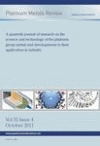-
oa Production of No-Carrier-Added105 Rh from Neutron Irradiated Ruthenium Target
- Source: Platinum Metals Review, Volume 44, Issue 2, Apr 2000, p. 50 - 55
-
- 01 Jan 2000
Abstract
Nuclear medicine radiotherapy involves the administration of a radiolabelled drug whose purpose is tissue damage and/or destruction at the point of localisation. Radionuclides useful for this application are those which emit particles (that is alpha, beta or Auger electrons) because they deposit their decay energy over a relatively short range (for example, at the tumour site). Rhodium-105 is a radionuclide with desirable nuclear properties for therapeutic applications (its half-life is 35.4 hours, the maximum α- energy is 0.56 MeV and it produces a 319 keV γ-ray suitable for imaging). However, this radionuclide is not readily available to most of the interested investigators due to the difficulty in production scale-up. The work reported here was designed to develop a viable method to produce and purify multi-millicurie quantities of 105Rh for radiotherapy research. Rhodium-105 was produced at the University of Missouri Research Reactor by the nuclear reaction, 104Ru (n, γ) → 105Ru (β- decay) → 105Rh and a new procedure was developed to chemically separate the no-carrier-added 105Rh from the neutron irradiated ruthenium target. Rhodium-105 production yields, for 10 runs, averaged about 5 mCi per milligram of ruthenium from a 72-hour irradiation at a thermal neutron flux of 8 × 1013 neutrons cm-2 s-1. Rhodium-105 was successfully isolated from the ruthenium radionuclides and the non-radioactive ruthenium. This new separation technique was fast (a total time of 3 hours) and highly efficient for removing the ruthenium. The decontamination factor of ruthenium averaged 16,600, indicating that only 0.006 per cent of the ruthenium remained after separation.


